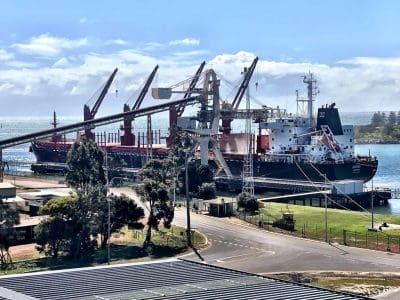NEWCASTLE and Port Kembla have joined Brisbane as ports repurposed for the receival and distribution of grain shipped in from South Australia and Western Australia, with oats for Hunter Valley horses and malting barley for Cargill’s Minto plant among the latest recipients.

Bunge’s Bunbury terminal in Western Australia loads oats and wheat last month on the Hupeh prior to its departure for Newcastle.
T.P. Sullivan principal Joe Sullivan, Mudgee, said WA oats, as well as wheat and barley, had been making their way to the Upper Hunter via the Port of Newcastle since last month.
“Most of it is going to feedmills, and to horse people, in Merriwa and that sort of area, because there’s not much grain left on farm,” Mr Sullivan said.
“This grain coming in by ship is filling a void, and I hope it will stop the prices from getting any higher.”
Mr Sullivan said the Liverpool Plains normally provided the Upper Hunter with the bulk of its feedgrain, but its worst season in decades this year had seen end-users looking to Newcastle to access shipped grain.
“The Liverpool Plains is a wonderfully reliable area, but they’ve missed out right through, so we’ve had to do something different this year.”
Between the GrainCorp terminal at Newcastle, with its storage capacity of 164,400 tonnes, and the 60,000t Newcastle Agri Terminal (NAT), the port seems to be settling into a pattern similar to Brisbane’s.
That means it is receiving two to three Handy-size cargoes carrying around 25,000-30,000t each per month.
Kembla has a greater storage capacity, with the GrainCorp terminal able to hold 260,000t, and Quattro 100,000t.
The recent expansion of Manildra Group’s Shoalhaven Starches plant at Bomaderry, 60 kilometres south of Kembla, is said to have lifted its annual grain usage to more than 700,000t, consolidating its position as Australia’s single biggest grain consumer.
It will make the plant the biggest user of grain shipped in via Kembla, with additional users being flour mills in Sydney, as well as Cargill’s Minto malting plant, which may soon be divested as part of a Cargill sell-off of its global malting division, if trade rumours in the United States and Australia prove correct.
Cargill may also be an importer of canola from southern Australia to supply its oilseed crushing plant at Kooragang Island, Newcastle.
Place for trains
While ships are discharging instead of loading grain at Kembla and Newcastle in response to eastern Australia’s drought, trains are also looking like they will change their role for the next 12 months.
Rail wagons have been kept busy loading grain for human-consumption markets, and are expected to play a part in getting feedgrain sourced through Kembla to upcountry sub-terminals in Junee, Temora and Parkes.
For some months, rail has already played an important part in bringing South Australian grain to Parkes, Sydney and Moree.
Robinson Grain Dubbo-based trader, Trent Robinson, said grain available off the ship at Newcastle and road-freighted west of the Upper Hunter had a price tag similar to that of grain road-freighted directly from Victorian storages.
“The only benefit for people who are drought feeding is that they get the freight rebate from Victoria, but not from Newcastle, so they might be getting a $40-$50/t rebate on grain which costs $80-$100/t to take from Victoria to Dubbo,” Mr Robinson said.
“That might be making it better value than paying $40/t to pull it out of the port at Newcastle.”
What might change that is the deployment of trains to take grain from Newcastle to sub-terminals at Werris Creek and possibly Moree, where grain will compete on price against road-freighted wheat and barley sourced through Brisbane.
“We don’t expect to take a grain from Walgett to Condobolin this harvest, and it’s a long time until next harvest, so grain railed out of Newcastle might end up working this far west.”
Grain Central: Get our free daily cropping news straight to your inbox – Click here

The fact Manildra’s ethanol plant is Australia’s largest grain user underlines another example of Australia’s broken political processes. Manildra is one of Australias largest political donors, both declared and undeclared. Google it.
What donors expect and in Manildra’s case get is a licence to print money. Mandating use of grain to make biofuel distorts the grain and petrol markets, is not scalable or sustainable, and places unnecessary burden on agricultural systems. If all the world’s arable land was used for biofuel, less than 15 per cent of global transport fuel would be produced. Biofuel mandates are a wombat-headed, duck-legged idiocy of a policy but we let them get away with it.